Since its inception three years ago ago by researchers at the Norwegian-based Ocean Space Acoustics (OSAC) the international fishing industry is eager to see the arrival of the ‘PingMe’ system – a scientific system that is set to bring an end to the financial and environmental impacts for fishermen who lose their pots, gill nets and even trawls. As well as giving critical information for the fishery about landing of the gear, temperature and currentinformation, the system provides more efficient fishing operations and season planning.
As well as the major financial loss for a skipper to lose his gear and catch, due to storms or being dragged away by another vessel, the environmental impacts of lost gear acting as ‘ghost fishing’ or seabed thrash has for many years been highlighted for the huge damage to fish stocks that it can cause.
And, as Sales and Marketing Director Petter Pettersen explains, that OSAC sprang out of SINTEF, Norway’s largest research institute: The idea was to find a workable and affordable solution to work towards achieving cleaner oceans but to also aid fishermen to avoid potential costly losses of fishing equipment and giving critical information.
From this high level marine scientific collaboration, and through a lengthy investment in research and development, the ‘PingMe’ was born – a smart tool for tagging gear and objects under water which, with new transponder technology or as a stand-alone (‘plug and play’) system, makes it easy to find and identify lost gear underwater.
The PingMe system can be used for better control during active fishing, by attaching transponders at regular intervals to the gear, better control of where the gear is currently located can make fishing more efficient and profitable.
Following some delays in development and production due to the global pandemic, PingMe will initially be on the market as an affordable ‘standalone’ system (i.e. sensor and wheelhouse-based signal reader).
System
Already described by many as a ‘game changer’, PingMe consists of a small, user-friendly sensor device or ‘egg’ which is attached to the gear before shooting and, with a software module integrated in the boat’s chart plotter, this device not only acts as a locator and location monitoring system but provides vital data on current water temperature and direction/strength of tidal conditions.
PingMe software allows communication with the transponder to determine location and ID and, as an added bonus, the system’s service can, if chosen, also report location and ID to ‘the ‘cloud’ where the information is also stored and therefore important reporting data of gear that is lost, detected and retrieved gear can be saved.
This not only enables the fisherman to monitor the location of his gear but could, depending on how many users are using the information available, help avoid conflicts with other boats or fisheries who can use the system to ‘see’ where gears are working.
The transponder itself carries both active and passive versions as it lies dormant until pinged upon by a vessel with a PingMe transducer and reflects the sound waves originating from the transducer on the vessel.
The reflected signal is encoded with a unique identity so that the sounder with PingMe software integrated can identity the transponder and calculate it’s position. This information can be encrypted if the information is to be transferred to the cloud.
An added bonus of this new product is that the system’s sensor also relays information on water temperature at its location – knowledge that can greatly benefit fishermen when choosing the site for shooting their gear.
Market forces
While initial interest was expressed by many fishermen across Europe, it was when renowned Norwegian gear manufacturer and supplier Morenot, with 33 outlets worldwide, became the registered distributor for PingMe that new avenues began to open up.
Fred Helge Kaald, Marketing Manager for Morenot’s Russian operation says there is much anticipation for the PingMe system, particularly for their crab fisheries in the Bering Sea. And the Icelandic and Faroese crabbing fleets have also expressed an interest.
“Previously the biggest challenge to pot fisheries in colder waters has been that when the seas have iced up and trapped the fishing gear as, once the ice packs begin to move, they drag the fishing gear out of position and traditionally this has caused many problems for fishermen to relocate the gear – the PingMe tool will now do away with this problem,” Mr Kaald commented.
“We had originally hoped to launch this to the market last autumn at NorFish but Covid caused the postponement of all such events – so now we’re hopeful of launching in the coming months,” he said, adding that the benefits and potential of this tool are not limited to pot fisheries.
“There are many long line vessels working in the South Pacific fisheries such as Patagonian Toothfish and the fact that there are stringent criteria attached to this fishery due to environmental concerns, the availability of a device that can ensure the recovery of any lost gear has been welcomed by fisheries managers and participants alike,” he said.

